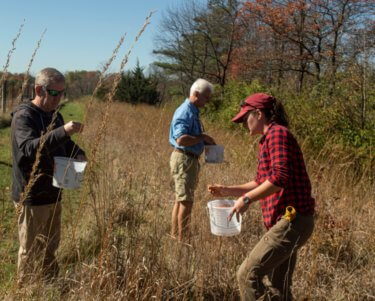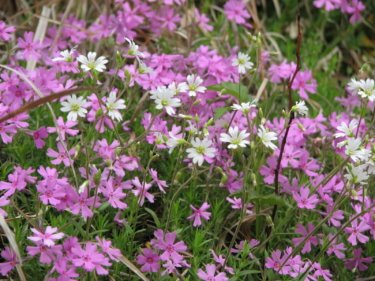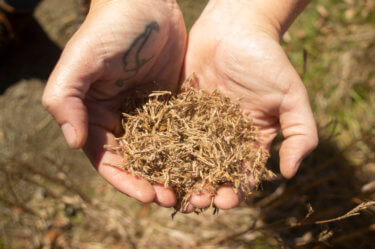Saving a Rare, Local Ecosystem
Seed Collection and Propagation Partnership Launched
MEDIA, Pa., November 13, 2019 – On a sunny autumn afternoon in late October, more than a dozen volunteers from non-profits Natural Lands and Tyler Arboretum joined forces to collect native plant seeds at Willisbrook Preserve, owned and managed by Natural Lands. The seeds will be propagated at Tyler Arboretum, and then planted at both Tyler’s Pink Hill and Natural Lands’ Willisbrook Preserve as part of a joint effort to re-introduce rare species of local genotypes to this serpentine barrens habitat.

Volunteers collecting seeds at Willisbrook Preserve (Photo: Mae Axelrod)
The serpentine barrens at Willisbrook Preserve, located in Malvern, are among just a handful of remaining serpentine grasslands in the eastern United States. Serpentine barrens contain serpentinite, a type of metamorphic greenish bedrock from which the soils are weathered. The soils’ chemical characteristics—high in magnesium and nickel and low in calcium—make them inhospitable to most plants. In fact, the term “barrens” was coined by farmers who noticed crops would not grow there. However, a few tenacious plant species have adapted to these extreme soil conditions. Many of these plants are rare, threatened, or endangered as are some of the animals that make the grassy habitat their home. Without the barrens, these native plants and animals could be lost.
The three-acre meadow known as Pink Hill, located at Tyler Arboretum in Media, was named for the candy-colored Phlox subulata that blooms there every spring. Like those at Willisbrook Preserve, the soils at Pink Hill are also underlain with serpentinite. The horticulture staff at Tyler want to augment the existing plant species growing there. By collecting and propagating seeds from nearby Willisbrook Preserve, plants added to the barrens will have the same local genotype.

Phlox subulata at Pink Hill (Photo: Roger Latham)
“The serpentine barrens ecosystem has much more in common with Midwest grasslands than with the forest vegetation that prevails here in the East,” said Dr. Roger Latham, ecologist and conservation biologist. “These two barrens are home to a fantastically diverse group of plants and animals, including several that are rare or endangered.”
Ironically, much of the loss of serpentine grasslands is due to inattention from humans. In our year-round moist climate, grasslands rely on periodic disturbance to prevent woodlands from overtaking them. For millions of years, this essential disturbance came from native animals: mastodons, mammoths, and herds of hungry elk kept trees at bay by browsing and trampling the ground beneath them. Grassland-sustaining disturbance was continued by indigenous peoples setting fires and later by livestock grazing and mining. Today, in the absence of these activities, bordering woodlands quickly encroach, creating their own rich soil layer over the inhospitable serpentinite as their leaves drop and decompose.

Photo: Mae Axelrod
“We’re delighted to be working with Tyler Arboretum on this important partnership effort to bolster the population of some rare barrens’ plants,” said Oliver Bass, president of Natural Lands. “Grasslands like those at Tyler and Willisbrook are living ecological relics that are worthy of our preservation and stewardship efforts.”
“Restoring Pink Hill to its original state is a significant undertaking, but one that we believe is certainly worth the wait and investment,” said Mandy Santiago, executive director of Tyler Arboretum. “We are thrilled to partner with Natural Lands, Department of Conservation and Natural Resources, Middletown Township and the community at-large to preserve one of the region’s most important and diverse ecosystems.”
Natural Lands is dedicated to preserving and nurturing nature’s wonders while creating opportunities for joy and discovery in the outdoors for everyone. As the Greater Philadelphia region’s oldest and largest land conservation organization, Natural Lands—which is member supported—has preserved more than 125,000 acres, including 44 nature preserves totaling more than 23,000 acres. Some 2.5 million people live within five miles of land under the organization’s protection. Land for life, nature for all. natlands.org.
The land that became Tyler Arboretum was purchased from William Penn in 1681. Today, Tyler provides a natural sanctuary for visitors interested in horticulture, history, and the natural world. With 650 acres of meadows, wetlands, and unbroken forest, and over 17 miles of hiking trails, Tyler is open every day for exploration and discovery, and as one of the oldest and largest arboreta in the northeastern United States, is an important community resource and cultural destination. Visit tylerarboretum.org or call 610-566-9134.
Media Inquiries:
Kirsten Werner, Senior Director of Communications
610-353-5587 ext. 267
kwerner@natlands.org
###
